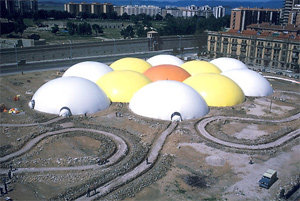The Pamplona Encounters 1972
dal 27/10/2009 al 21/2/2010
Segnalato da
Press office Museo Reina Sofia
Zaj
Valcarcel Medina
Lugan
Nacho Criado
Francesc Torres
Antoni Muntadas
Navarro Baldeweg
Jose' Diaz Cuyas
Carmen Pardo
Esteban Pujals
27/10/2009
The Pamplona Encounters 1972
Museo Nacional Centro de Arte Reina Sofia, Madrid
The exhibition draws from the Pamplona Encounters in 1972, Spain's most internationally renowned avant-garde festival, as a point of departure for revisiting experimental art from the period. The event represented the culmination of experimental artistic practices from the 1960s, at once their height and a turning point that flagged the decline of these tendencies. Some of Spain's most featured representatives in art are contextualized in the exhibition, among them Zaj, Valcarcel Medina, Lugan, Nacho Criado, Francesc Torres, Muntadas, and Navarro Baldeweg, to cite only a few examples.

curated by José Díaz Cuyás, Carmen Pardo and Esteban Pujals
This exhibition draws from the Pamplona Encounters in 1972, Spain’s most internationally renowned avant-garde festival, as a point of departure for revisiting experimental art from the period. The event represented the culmination of experimental artistic practices from the 1960s, at once their height and a turning point that flagged the decline of these tendencies. At the time, the term “experimental” alluded to works that called into question the material limits of their chosen media, whether poetry, cinema, music, painting or sculpture. But above all, the event constituted an unprecedented staging of contradictions in avant-garde movements, particularly among the official avant-garde (Abstract and Concrete Expressionism, Social Realism, Pop art, etc.) and those we could designate “iteralists”, or—in a less precise, broader term—Conceptual movements.
The exhibition, then, approaches its subject by observing what transpired in the years before and after the Encounters, thereby tracing the failures and greatest achievements of Spanish art linked to the end of the avant-garde myth. On the other hand, given the event’s magnitude, we should associate the Encounters with the phenomenon of Biennials and Documentas (particularly, Ducumenta V), which proved fundamental to legitimizing the 1960s artistic practices. This offers us a real, concrete example to contextualize experimental practices in Spanish art within an international scope.
The exhibition, curated by José Díaz Cuyás with assistance from Carmen Pardo for the music section and Esteban Pujals for poetry, will host some one hundred works in different formats. The showing also includes historically significant works and documentary materials that are not related specifically to art, (photography, films, recordings, visual documentation, etc.) and which serve as the exhibition’s backdrop and context. Because many of the works in question are ephemeral pieces or actions, documentary and archival research (often inseparable from these practices) is fundamental to their very nature.
The exhibition layout follows a chronological order in an attempt to reconstruct what happened in those eight days during the Encounters, displaying works juxtapose archive materials (press, photography, cinema, video, audio recordings and interviews with its key figures), and likewise includes all of the events that transpired around it (ETA bombs, gathering protesters, etc.).
One section before entering the exhibition is dedicated to Alea, an organizational entity, and its intense activities in managing and programming contemporary music during the 1960s.
Some of Spain’s most featured representatives in art are contextualized in the exhibition, among them Zaj, Valcárcel Medina, Lugán, Nacho Criado, Francesc Torres, Muntadas, and Navarro Baldeweg, to cite only a few examples.
The exhibition includes experimental poetry by Spanish and international authors, experimental cinema both in Spain and in an international scale, as well as avant-garde cinema (the historical avant-garde’s primitive cinema and the most recent independent filmmaking) with collaboration from the renowned director of the French Film Archives, Langlois, and guidance from George Sadoul. In video, the exhibition’s highlights include the recuperation of part of the collection for the “This is your roof” series produced by Willoughby Sharp for the Pamplona Encounters in collaboration with Muntadas and Dennis Oppenheim, who attended in person. The latest tendencies in experimental music, both in Spain and on an international scale, were widely represented at the Encounters (repetitive music, action music, electroacoustics, etc.). Regarding computer art, the exhibition contextualizes works made by Computing Centers on an international scale.
Image: Cupulas de Jose' Miguel de Prada Poole, Foto: J.M. de Prada Poole
Museo Nacional Centro de Arte Reina Sofia
Building Sabatini, 3rd Floor, Rooms 301, 302, 303, 304 y 308
Santa Isabel, 52, Madrid
Mon-Sat 10-21 h, Sun 10-14:30 h, Tue Closed
General Admission 6, Temporary Exhibitions: 3



